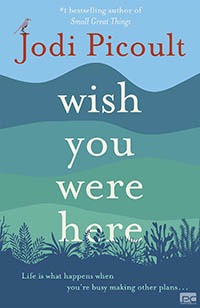
Wish You Were Here
Jodi Picoult
For Melanie Borinstein, soon to be the newest member of our family.
There’s no one else I’d rather run a quarantine salon with.
According to Darwin’s Origin of Species, it is not the most intellectual of the species that survives; it is not the strongest that survives; but the species that survives is the one that is able best to adapt and adjust to the changing environment in which it finds itself.
—LEON C. MEGGINSON
ONE
ONE
March 13, 2020
When I was six years old, I painted a corner of the sky. My father was working as a conservator, one of a handful restoring the zodiac ceiling on the main hall of Grand Central Terminal—an aqua sky strung with shimmering constellations. It was late, way past my bedtime, but my father took me to work because my mother—as usual—was not home.
He helped me carefully climb the scaffolding, where I watched him working on a cleaned patch of the turquoise paint. I looked at the stars representing the smear of the Milky Way, the golden wings of Pegasus, Orion’s raised club, the twisted fish of Pisces. The original mural had been painted in 1913, my father told me. Roof leaks damaged the plaster, and in 1944, it had been replicated on panels that were attached to the arched ceiling. The original plan had been to remove the boards for restoration, but they contained asbestos, and so the conservators left them in place, and went to work with cotton swabs and cleaning solution, erasing decades of pollutants.
They uncovered history. Signatures and inside jokes and notes left behind by the original artists were revealed, tucked in among the constellations. There were dates commemorating weddings, and the end of World War II. There were names of soldiers. The birth of twins was recorded near Gemini.
An error had been made by the original artists, so that the painted zodiac was reversed from the way it would appear in the night sky. Instead of correcting it, though, my father was diligently reinforcing the error. That night, he was working on a small square of space, gilding stars. He had already painted over the tiny yellow dots with adhesive. He covered these with a piece of gold leaf, light as breath. Then he turned to me. “Diana,” he said, holding out his hand, and I climbed up in front of him, caged by the safety of his body. He handed me a brush to sweep over the foil, fixing it in place. He showed me how to gently rub at it with my thumb, so that the galaxy he’d created was all that remained.
When all the work was finished, the conservators kept a small dark spot in the northwest corner of Grand Central Terminal, where the pale blue ceiling meets the marble wall. This nine-by-five-inch section was left that way intentionally. My father told me that conservators do that, in case historians need to study the original composition. The only way you can tell how far you’ve come is to know where you started.
Every time I’m in Grand Central Terminal, I think about my father. Of how we left that night, hand in hand, our palms glittering like we had stolen the stars.
It is Friday the thirteenth, so I should know better. Getting from Sotheby’s, on the Upper East Side, to the Ansonia, on the Upper West Side, means taking the Q train to Times Square and then the 1 uptown, so I have to travel in the wrong direction before I start going in the right one.
I hate going backward.
Normally I would walk across Central Park, but I am wearing a new pair of shoes that are rubbing a blister on my heel, shoes I never would have worn if I’d known that I was going to be summoned by Kitomi Ito. So instead, I find myself on public transit. But something’s off, and it takes me a moment to figure out what.
It’s quiet. Usually, I have to fight my way through tourists who are listening to someone singing for coins, or a violin quartet. Today, though, the platform is empty.